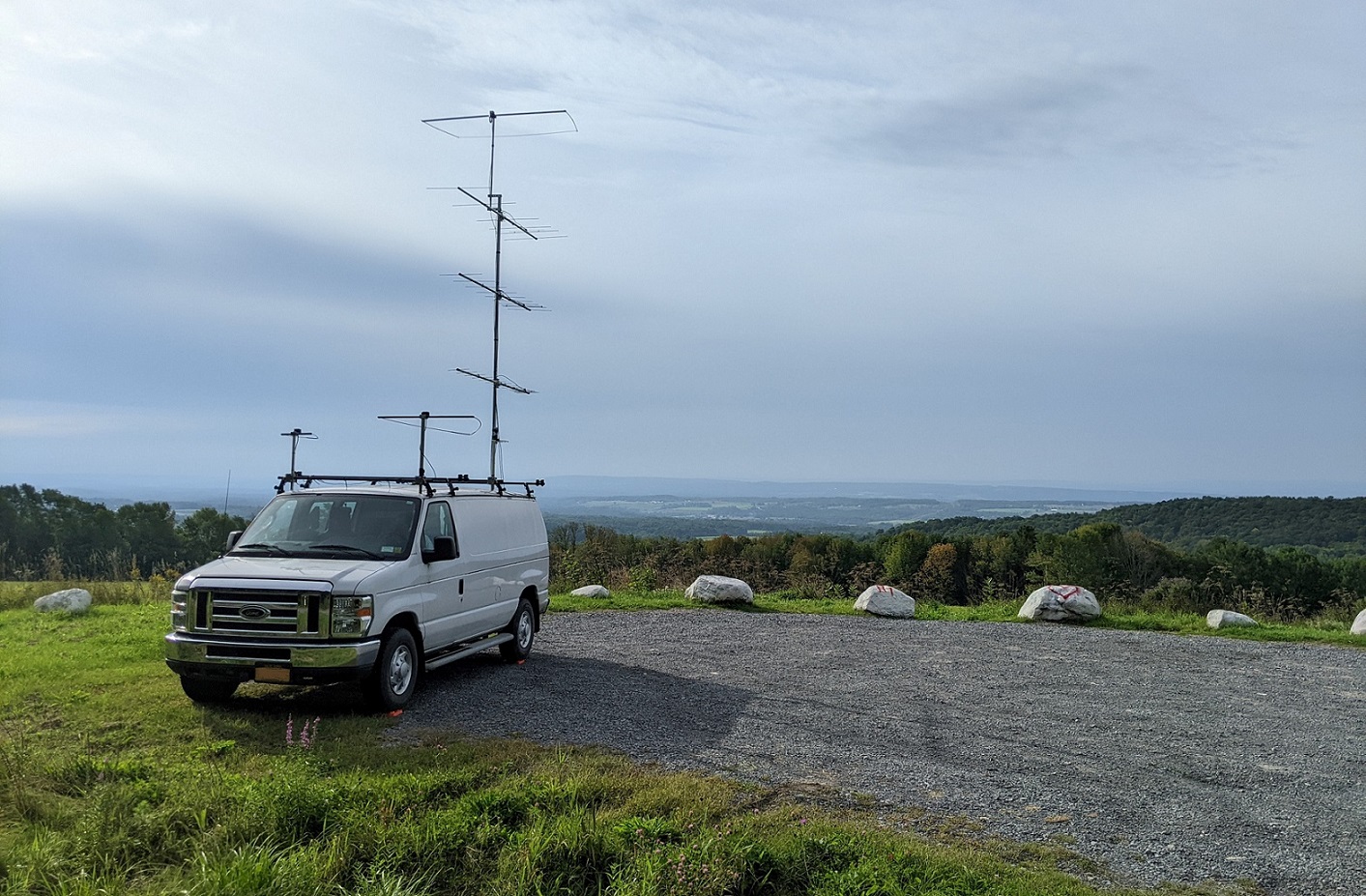
N2SLN/analog rover in FN23 - photo KB2YSI
The plan was to move east to my good-performing spot in northwest FN21. Unfortunately, one thing I did not think to research was the speed limit on the roads I had planned to take. As it turns out, most of them were 45 mph, not 55 mph. So I had less on-air time than I would have liked. Lesson learned. The highlight was working K1WHS in the state of Maine on all 3 bands we had in common. When I got home, I replaced the 6m loop with a Moxon and threw the 6m antenna switch to the other position which includes a coaxial balun for the Moxon, and we were now ready for the next day, which includes only roadside pulloffs instead of shoulder-of-the-road operations.
Sunday morning I picked up Don and we continued to our first location which was in the southwest quadrant of FN23. Activity was as good as the old days and this turned out to be our most productive grid activation, both in terms of the sheer number of contacts and how quickly we made them. One highlight was working a Long Island QRP station on a 207-mile path on 6m/2m. He said he had heard the K2DLL/B in FN23 at higher signal strengths than usual on Saturday and hoped it would last long enough to work someone in FN23. Either the conditions persisted, or it was just the QRN-free location and lots of filtering on the equipment that allowed us to hear him. We have worked him before from this spot.
Next we headed west and tried a new location in southeastern FN13. The site was not particularly high in elevation, but the tree attenuators were several hundred feet away, so the main lobes probably had enough room to scatter upward without being blocked much. With the low elevation hitting at the same time as the low activity time of day and with our lack of familiarity with the quality of this site, we were scheduled to spend only 90 minutes here to limit the suffering. We were happy to find no power lines nearby and no QRN on any band, and we even picked up several new grids.
The interstate was only a couple minutes away, and we were quickly making progress to a northeast FN12 hilltop, also a new location for us. When I scouted this site in August, there was no QRN on 6m/2m. Before the contest, I had placed a bandpass filter on the 432 station in order to fight any broadband noise from the onsite channel 14 (470-476 MHz) UHF television transmitter. That worked for 432 because that band was quiet, but 6m had S9 noise when pointed toward the equipment building. Maybe a leaky insulator on a utility pole, since there was rain during the contest but not during the earlier scouting of the site...or maybe equipment in the building or maybe the transmitter antenna itself. Despite the challenges, the site turned out to work alright for us, and we did work into southern FM19 on all 4 bands for a new grid, as well as pick up new grid FN10 thanks to N2XRE/R.
We headed east, still on schedule, for our fourth new location this weekend and sixth grid. We got rained on for the fourth time today, but it was light rain each time. This would be our final grid activation for the contest--a roadside pulloff in northern FN22 with some tree blockage to the west. This turned out to be the second best site in terms of activity levels. At one point there was a station who only had FM on the 220 band, so we told him we would go to 223.500 FM simplex and call CQ so he could turn his antenna and peak our signal. We did that, but it was a different station who answered. It was VE3ZV for a distance of 225 miles / 363 km and a new grid despite the tree blockage.
Only 443 miles traveled this weekend versus 500+ in the past shows that we succeeded in planning a more compact route around the Syracuse, NY grid corner.
The claimed score was down a bit from other scores in the past 10 years, but I noticed on the first day that there was no DX being heard (nothing beyond 300
miles), so propagation was probably less than neutral. Activity levels were definitely down, as some multi-ops were noticed struggling with staffing issues
(possibly due in part to the current COVID spike), as well as equipment and procedural issues--there were many more incomplete band runs than usual and long
periods of inactivity from them. Plus, K1RZ was getting his tower re-worked and was off the air. But we still had fun and did more site research than usual.
No effort yet from the ARRL to provide the analog-only sub-category for anyone other than single operators. Update: N2SLN/R takes
second place.
POINTS SUMMARY
Band QSOs QSO pts. Mults.
------------------------------------------------
50 65 65 19
144 65 65 20
222 45 90 17
432 44 88 16
------------------------------------------------
TOTALS 220 308 72
+6 grids activated
78
--- Claimed score = 24,024 ---
